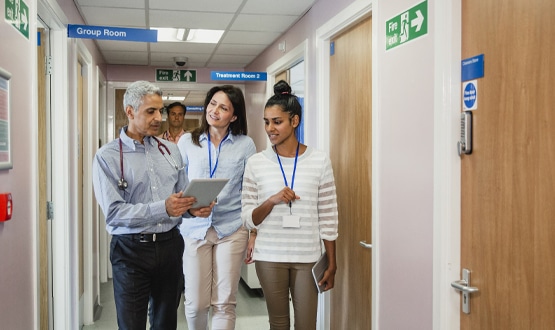Siemens at the crossroads
- 22 May 2007
 Last week, Klaus Kleinfeld, chief executive of Siemens, resigned after a boardroom coup against him. His resignation followed the stepping down of Siemens chairman, Heinrich von Pierer a week earlier.
Last week, Klaus Kleinfeld, chief executive of Siemens, resigned after a boardroom coup against him. His resignation followed the stepping down of Siemens chairman, Heinrich von Pierer a week earlier.
Kleinfeld (pictured right) had transformed the company, one of Europe’s largest. A former boss of the medical division, as chief executive he led efforts to push the company into a leading position in healthcare IT. In the US in particular, his effect has been marked. Under him, Siemens broke out of its clinical modality niches in medical imaging, and has come to be seen as a leading player in the US healthcare IT integration market.
He effected wide-ranging changes to the 160 year-old German conglomerate, and sold off whole divisions. He made the company far more open, instituted American business practices, and transferred a number of the company’s divisions from Germany to the US. As he stated in interviews, Kleinfeld saw these as essential to opening the company to new alliances and partnerships. Amongst its divisions, one of the undoubted beneficiaries of this new openness has been the company’s healthcare technology business.
Siemens has, of course, been involved with healthcare IT for a long time. It is not only the world’s oldest medical technology company, it can also claim, through its subsidiary Zuse, to be the world’s oldest computer company as well. Healthcare computing was a natural extension of its existing businesses.
In the UK it is a major player in NHS computing and medical technology. It successfully built – without a great deal of fanfare – much of Norway’s nationwide electronic patient record system. And the company has always played a major role in healthcare IT in its home market.
But the alliances forged by Kleinfeld – in particular with Microsoft – have allowed the company to move beyond conventional EPR into new territory.
The first fruit of this new approach is the twinset of Soarian and Syngo. Soarian is an advanced electronic clinical record combined with clinical workflow. Hospital processes like cardiology can be embedded into Soarian, providing both workflow efficiencies, and the provision of specialist tools at each appropriate stage – such as special diagnostics tools for consultants.
Syngo bolts turbochargers onto Soarian. It equips Soarian with the ability to handle all manner of medical imaging and device data. Syngo dives down to the microcode level, providing on a Windows machine the performance and functionality of an embedded system. This combination has allowed Siemens to produce packages for cardiology, ICU, disease management and the operating department that incorporate specialty device and modality data.
To this, Siemens has added artificial intelligence. It is rolling out a series of diagnostic tools that equip specialists with computer-added detection (CAD) features. An example of this approach is Syngo Lung CAD, which automates the detection of lung nodules in CT scans. Another is in echocardiography.
Under Kleinfeld’s watch, Siemens has also taken a leading position in the growing electronic health record (EHR) movement in the US. It is widely seen as a leader in the Integrated Healthcare Enterprise (IHE) industry interoperability initiative and is well positioned to capture a major role in the US government’s plans to create a continent-wide EHR system.
Finally Siemens has begun to assemble the components to build individualised medicine. It has entered into alliances or mergers with companies such as Diagnostic Products Corporation, Specialty Laboratories, SEQUENOM, Schering and Bayer Diagnostics. It is providing the company with the advanced molecular diagnostics it needs to build the software systems to support the molecular medicine of the next decade. At present, Siemens and GE are far ahead in a field that will dominate future hospital IT.
How will Kleinfeld’s going affect this progress? Is the toothpaste out of the tube, or is Siemens in danger of stumbling now the chief advocate of its healthcare transformation has resigned from the company.
Certainly, Siemens needs to continue to build alliances and would be unwise to turn its back on the reforms instituted by Kleinfeld and von Pierer.
But his departure was not welcome news in the US. Not only was Kleinfeld known and liked by many who count in America, he was also admired for his personal championing of New York after 9/11.
In interview after interview, Kleinfeld stressed the need for Siemens divisions to “value-add”. Behind this was the fear that companies like Siemens could be overtaken in straightforward hardware. The company’s lead in MRI and CT is potentially vulnerable to heavy Chinese investment in R&D going into this area. Kleinfeld’s strategy was to build value through advanced clinical software – such as Soarian and Syngo – and add artificial intelligence, automated detection and clinical workflow. But most of all, he created a world leading position in individualized medicine, rivalling GE’s.
Is that at risk? The simple answer is: yes, possibly, but the hope must be that it is not. The position he created for Siemens in the US marketplace was very much associated with him personally. This allowed alliance building, and has given Siemens privileged access to the US healthcare IT market.
All eyes will be on how his successor manages the advantageous position that has been created – and, of course, on what Klaus Kleinfeld decides to do next.




